#Kentrosaurus aethiopicus
Text


#Archovember Day 22 - Kentrosaurus aethiopicus
Much smaller than its cousin Stegosaurus, Kentrosaurus aethiopicus was still a very unique stegosaur. From the Late Jurassic of Tanzania, Kentrosaurus had multiple means of defense: from a row of plates down its back that gradually merged into spikes, to longer spikes on the end of the tail, and even spikes on each shoulder! Well… probably. These two unique, broad-based spikes were not found attached to the animal. Classically, they were placed on the hips. However, the more recent discoveries of Gigantspinosaurus and Huayangosaurus had shoulder spines, so it is now typically placed on the shoulders.
Kentrosaurus was a herbivore and did not seem to do much chewing, instead swallowing its food in large chunks, probably also swallowing stones to help grind its food. It would have eaten low-growing food and fruit, though it may have also been able to rear up on its hind legs to reach higher vegetation.
There seem to have been two seperate morphologies of Kentrosaurus: one robust and one gracile. It is suggested that these represent sexual dimorphism, with the more common robust form being females and the less common gracile form being males. However, the ratio of common/uncommon may be skewed by the robust form being more easily fossilized.
Kentrosaurus aethiopicus lived alongside the small iguanodontian Dysalotosaurus, sauropods like Giraffatitan and Dicraeosaurus, theropods like Elaphrosaurus and Veterupristisaurus, and small mammals like Brancatherulum.
169 notes
·
View notes
Photo
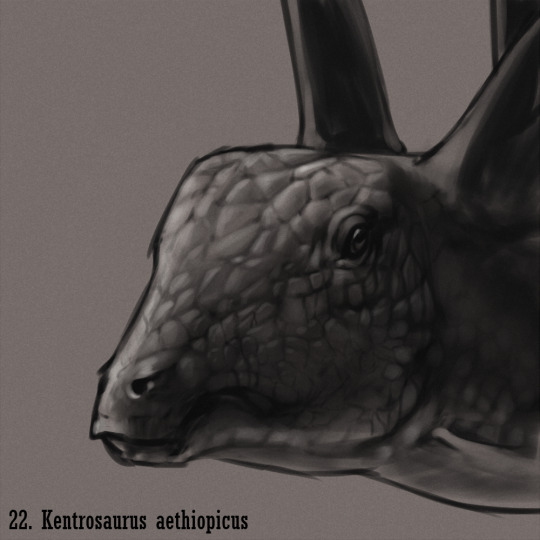
Day 22: Kentrosaurus aethiopicus
#Kentrosaurus aethiopicus#Kentrosaurus#Stegosauridae#Stegosauria#Eurypoda#Thyreophora#paleoart#paleoblr#palaeoblr#dinosaur#paleontology#archovember#archovember2022#dinovember2022#dinovember#art#digital art
44 notes
·
View notes
Text
Kentrosaurus is a relatively small herbivorous dinosaur that lives in dense forests where large animals have trouble getting around, aside from the occasional utahraptor it has no natural enemies.
Kentrosaurus can be tamed by feeding them berries over multiple intervals, but will become aggressive if you take too long to feed them (you can still tame them, you'll just get impaled in the process) and can perform a double AOE attack which is deadly to both enemies and allies.
In real life, kentrosaurus is a smaller relative of stegosaurus that lived in Africa during the late Jurassic, its name means "pointy lizard" for obvious reasons.
3 notes
·
View notes
Text

Kentrosaurus aethiopicus
7K notes
·
View notes
Text

Jurassic June 2024 Day 20: Kentrosaurus aethiopicus
#dinosaur#dinosaurs#jurassic june art challenge#jurassic june 2024#jurassic june#late jurassic#kentrosaurus#stegosaurs#stegosaur#stegosauria#thyreophora#paleontology#paleoart#palaeontology#palaeoart#palaeoblr#paleoblr#paleoartists on tumblr
119 notes
·
View notes
Text
So giving them robo arms to hold their shit has been the best decision ever (info after imgs)
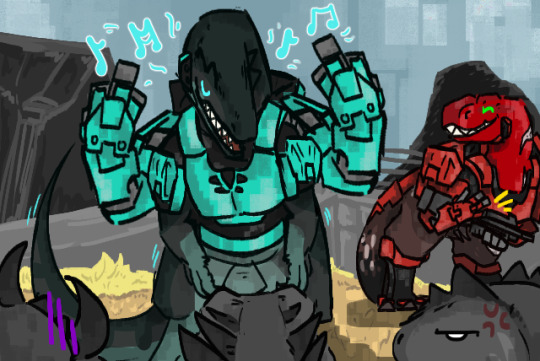

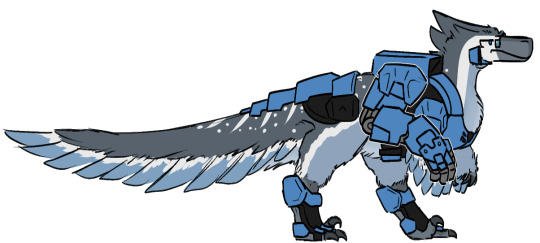
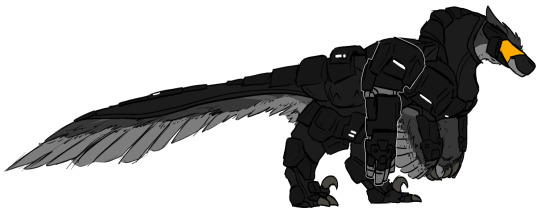
So im going absolutely feral about this AU, so in order to make sure they can still fight their war with guns i gave them robotic arms attached to the thingys on their armour.
Sim Troopers and regular soldiers have about what Church/Sarge wear, while Freelancers and special ops like Locus and Felix are closer to Tex. Hiding specific markings + making them more resilient.
Also please enjoy this height reference I've made (Locus gets honorary Red bc he deserves it). Some heights have been changed to be larger, in Lopez and Tex's case have been drastically changed as they are robots. Nerd stuff about who is what below.

Caboose [Ankylosaurus magniventris]
Church, Carolina, Tex [Utahraptor ostrommaysi]
Washington [Megalosaurus bucklandii]
Tucker [Allosaurus fragilis]
Doc [Kentrosaurus aethiopicus]
Donut [Deinonychus antirrhopus]
Grif, Kaikaina [Pachyrhinosaurus lakustai]
Simmons [Maiasaura peeblesorum]
Sarge [Daspletosaurus torosus]
Lopez [Nasutoceratops titusi]
Locus [Lythronax argestes]
Edit: I forgot Donut and Doc my sons I'm so sorry the bit has breached containment
#RvB Dino AU#dinosaurs#rvb art#rvb church#rvb tex#rvb sarge#red vs blue art#rvb tucker#red vs. blue#dinosaurification ray#the tism
80 notes
·
View notes
Text

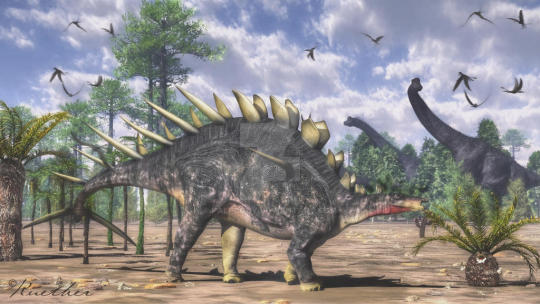

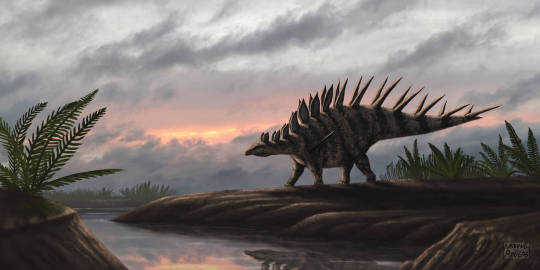

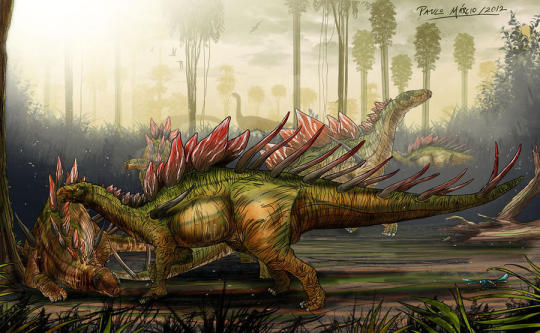
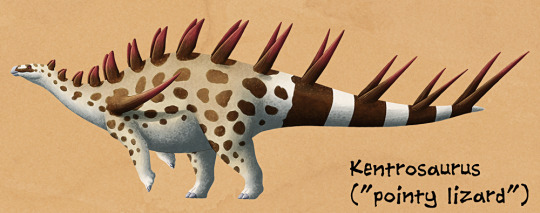
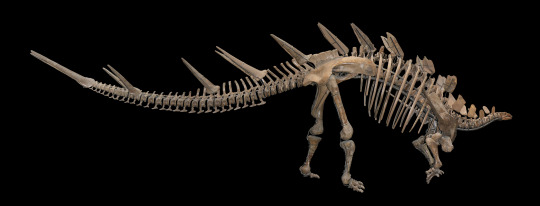

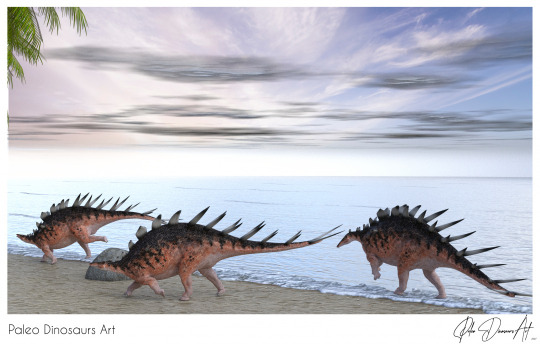
Kentrosaurus is a genus of stegosaurid dinosaur which lived throughout what is now Africa during the Kimmeridgian and Tithonian ages of the Jurassic period some 154 to 145 mya. The first fossils of Kentrosaurus consisting of the partial remains of over 50 individuals were discovered by the German Tendaguru Expedition in 1909. These remains were described by German palaeontologist Edwin Hennig in 1915, who gave them the name Kentrosaurus from the Greek kentron meaning "sharp point" or "prickle", and sauros meaning "lizard", with the specific name aethiopicus denoting the provenance from Africa in which the remains were found. As of today roughly 350 specimens have been recovered. Kentrosaurus once almost lost its name because of the ceratopsian dinosaur Centrosaurus. This gave rise to the alternate names of Kentrurosaurus and Doryphorosaurus. However not only are Kentrosaurus and Centrosaurus spelled diferently they are pronounced differently, Kentrosaurus with a ‘kicking K’, and Centrosaurus with a soft C pronounced more like an S. This is why renaming was never really required and Kentrurosaurus and Doryphorosaurus are considered synonyms. Reaching some 13- 15ft (4 -4.5m) in length and 1,500 to 3,500lbs (700 to 1,600kg) in weight, kentrosaurus is a comparatively small stegosaur characterised by a small head, a long neck, short forelimbs and long hindlimbs, and a long, horizontal and muscular tail. Said long tail of Kentrosaurus results in a position of the center of mass that is unusually far back for a quadrupedal animal, meaning kentrosaurus would have been surprisingly agile and flexible. The most impressive feature of kentrosaurus has to be its armaments consisting of a pair of long shoulder spikes and an array of plates and spikes running along both sides of the top mid-line of the animal, resulting in the animal posing a staggering 12 thagomizers. In life kentrosaurus likely lived in herds browsing upon low to mid level vegetation.
Art used can be found at the following links:
#pleistocene pride#pliestocene pride#mesozoic#jurassic#kentrosaurus#stegosaur#dinosaur#extinct#fossil
1 note
·
View note
Text
Kentrosaurus aethiopicus

By José Carlos Cortés on @ryuukibart
PLEASE SUPPORT US ON PATREON. EACH and EVERY DONATION helps to keep this blog running! Any amount, even ONE DOLLAR is APPRECIATED! IF YOU ENJOY THIS CONTENT, please CONSIDER DONATING!
Name: Kentrosaurus aethiopicus
Name Meaning: Sharp Point Reptile
First Described: 1915
Described By: Henning
Classification: Dinosauria, Ornithischia, Genasauria, Thyreophora, Eurypoda, Stegosauria, Stegosauridae
Kentrosaurus is one of the more famous Stegosaurs, at about 4.5 meters in length, making it an actually fairly small stegosaur despite being a well-derived one. It had a long tail with many large spikes, as well as spikes on its shoulders; it would have had very robust hindlimbs and forelimbs to support the weight of it’s very heavy tail as a result. It’s plates and spikes were probably covered in horn, and they were always in rows of two along the back of the animal. It is known from many specimens, as well, making it one of the best known stegosaurs. Like other stegosaurs, it had a fairly flat head, and a long neck. Though it has been thought to have skeletal sexual dimorphism, this is under question and debate and requires further investigation. Kentrosaurus was also found to have a faster growth rate than either Stegosaurus or Scutellosaurus, throwing a wrench in the hypothesis that larger dinosaurs grew quicker than smaller ones.

By Jack Wood on @thewoodparable
Kentrosaurus lived in the Tendaguru Formation of Tanzania, which was remarkably similar to the Morrison and Lourinhã Formations of the same time. It lived about 155 to 150 million years ago, in the Kimmeridgian to Tithonian ages of the Late Jurassic. It’s hips were probably able to support the animal standing on it’s hind limbs, which it could have used to reach up and eat higher levels of foliage. The tail was extremely mobile, allowing it to swing its tail at predators and use its extensive spines to cause large amounts of damage, and groups of predators probably would have been the only ones capable of attacking it. It lived alongside many other dinosaurs in an environment filled with shallow lagoons, tidal flats, and coastal environments, feeding mostly on conifers. Other dinosaurs it shared its environment with included Dysalotosaurus, Giraffatitan, Dicraeosaurus, Janenschia, Tendaguria, Tornieria, Elaphrosaurus, Veterupristisaurus, Ostafrikasaurus, and the pterosaur Tendaguripterus.
Source:
https://en.wikipedia.org/wiki/Kentrosaurus
Shout out goes to @peketostuffs!
#kentrosaurus#kentrosaurus aethiopicus#dinosaur#stegosaur#palaeoblr#peketostuffs#paleontology#prehistory#prehistoric life#dinosaurs#biology#a dinosaur a day#a-dinosaur-a-day#dinosaur of the day#dinosaur-of-the-day#science#nature#factfile#Dìneasar#डायनासोर#ديناصور#ডাইনোসর#risaeðla#ڈایناسور#deinosor#恐龍#恐龙#динозавр#dinosaurio#공룡
72 notes
·
View notes
Text
Tuesday 12/10/21 - Dinosaurs of the World Part 3: Africa

Mohamad Haghani - Carcharodontosaurus feeding on an Ouranosaurus, Spinosaurus fishing out an Onchopristus
Like Asia, Africa was not the first place dinosaurs were found, but after palaeontologists from Britain, America, and Germany started excavation expeditions there, many exciting fossils were found, and continue to be found there today. In particular, a series of German expeditions in the 1910s to Tanzania was the largest fossil excavation in history, and many dinosaurs famous throughout the world have been attributed to this site.
Mesozoic Africa was connected to both South and North America at different stages of time, so dinosaur genera in Africa bear a strong resemblance to many American species that the public are familiar with. Stegosaurs, and Brachiosaurs from North America, Abelisaurs, and Dicraeosaurs from South America, and even a splash of Europe in Spinosaurs. But this melting pot of various dinosaur species have created a unique assemblage of reptiles unique to Africa.
Giraffatitan brancai

Giraffatitan, Phil Wilson
Giraffatitan was an incredibly large sauropod known from Late Jurassic rock in modern Tanzania. Originally, palaeontologists thought that this dinosaur was an African species of the American Brachiosaurus, but it since been given its own genus. Funnily enough if you think to yourself what you think Brachiosaurus looks like, you're probably picturing Giraffatitan, since the fragmentary American specimen has had its head and neck largely based on the much more complete Tanzanian specimen.
Giraffatitan very simply means "titanic giraffe". Macronarian sauropods, which Giraffatitan and Brachiosaurus belong to, have a much more upright, Giraffe-looking neck/shoulder posture compared to the more horizontal neck posture of other sauropods. It was a high browsing animal, eating from treetops, like a... giraffe. It's estimated adult size was about 25m long and 12-15 m tall.
Carcharodontosaurus saharicus

Carcharodontosaurus, Neil Redfield
Carcharodontosaurus was a large therapod described from Late Cretaceous Algeria and Egypt. It's very long genus name actually calls reference to another creatures scientific name the Great White Shark, Carcharadon, which means "Jagged Tooth". So the full name means "Jagged Toothed Reptile from the Sahara".
Originally just described from these shark-like teeth in 1925, Carcharodontosaurus was originally classified as a species of Megalosaurus (the first dinosaur named), but later findings allowed the shark-toothed dino its own genus. It was a large therapod, estimated to be as large or larger than Tyrannosaurus or Giganotosaurus, 12-13 m long and 4-5 m high. It was one of the largest meat eating dinosaurs of all time and probably the apex of ancient North Africa.
Kentrosaurus aethiopicus

Kentrosaurus, Kuzim (deviantart/twitter)
Kentrosaurus was a smaller Stegosaur found from Tanzania. It was a late Jurassic African relative of Stegosaurus, but significantly smaller, and with a different arrangement of ornamentation on its back. Kentrosaurus means "sharp/prickled reptile", and this was due to the range of spines on the dinosaurs back and shoulders. Stegosaurus is well known for its pentagonal plates that continue from its neck all the way to the middle of its tail, but in Kentrosaurus, these plates end just past the shoulders as the rest of the back is lined with large defensive spikes, ending with the infamous thagomizer on the end of its tail. Unique to this genus, it also had large spikes on each of its shoulder blades too. Kentrosaurus was just under a metre tall at the shoulder (not counting spikes), and about 4.5 m long.
Heterodontosaurus tucki

Heterodontosaurus, @viergacht on tumblr
Heterodontosaurus was a very odd basal Ornithischian dinosaur from Early Jurassic South Africa. Ornithichia is the side of the dinosaur family tree opposite to sauropods and therapods. Heterodontosaurus was very unique dinosaur that had a range of traits unique to its specific branch of the dinosaur tree. Heterodontosaurus translates to "different-toothed reptile", and this name reflects the most peculiar aspect of its family.

Heterodontosaurus skull (wikipedia)
Most dinosaur skulls, and indeed, most reptile skulls, have just one type of teeth in their jaws. Meat eaters have the same type of sharp tooth from front of skull to back, plant eater jaws are filled with just plant eating teeth etc. True Heterodonty is a condition mostly associated with mammals, where different parts of the mouth have different shapes, so this dinosaur is truly unique in its clade. It had pointed incisor-like teeth at the front, tusk/canine-like teeth just after that, and blunt, thick molars at the back of the mouth. The arrangement of these teeth are most similar to modern herbivores or opportunist omnivores, so this is the likely diet supposed by scientists.
Coelophysis rhodesiensis/Megapnosaurus r.

Coelophysis, Akeiron (deviantart)
Coelophysis was small, early therapod that lived in the Late Triassic period. This genus has had species described from many places, and in fact, the first species, Coelophysis bauri, was found in North America. Found in South Africa, C. rhodesiensis was originally known as Syntarsus, but this name was already taken a beetle. Then it was long known as Megapnosaurus (meaning "big dead lizard"), but recent studies have found it might be a subspecies of Coelophysis. Coelophysis means "hollow form", referring to the light bone structure of the small bodied dinosaur. This dinosaur is widely known as the poster child of Triassic period dinosaurs, as it is one the most well known early dinosaurs. Unlike many other later therapods its size, paleoartists do not often depict Coelophysis with a thick feather coating, as it was too primitive and early in the tree to have developed much more than a super wispy coating of the most primitive types of feathers.
Rugops primus

Rugops, Raul A Ramos
Rugops was a Late Cretaceous therapod found from Niger. It was part of the Abelisaurid family, a group of dinosaurs with ridiculously functionless arms, long legs, and blunt faces. Rugops was a bit on the smaller side for an Abelisaur compared to South American relatives such as Carnotaurus, at about 1.5 m tall and 5.5 m long. Rugops translates to "wrinkled face", a reference to grooves found along the length of skull, perhaps indicating the presence of a soft tissue crest, but more evidence will be needed to be sure. Given how short Rugops is compare to its active hunting South American relatives, palaeontologists think Rugops would only hunt smaller animals, or possibly scavenged for most of its food.
Dicraeosaurus hansemanni

Dicraeosaurus, Stolpergeist (deviantart)
Dicraeosaurus was a smaller Sauropod from Late Jurassic Tanzania. In stark contrast to Giraffatitan, who had a relatively long neck, Dicraeosaurus had a comically short neck for a sauropod. The Dicraeosaurids, a family of sauropods named after this dinosaur, were evolved for more of a low-browsing lifestyle. Meaning they ate smaller shrubs and ground level plants, leaving the tree-tops for the Brachiosaurs. Its name means "bifurcated head reptile", referring to the large vertebral spines just behind the head, which many paleoartists have reconstructed as a humped neck. These long neck spines are much more exaggerated in its South American cousins Amargasaurus and Bajadasaurus.
Spinosaurus aegyptiacus

Spinosaurus, MALvit (deviantart)
Spinosaurus was a large therapod known from Late Cretaceous Egypt and Morocco . It was part of a group of reptiles called the Spinosaurs (obviously named for Spinosaurus), that had crocodile-like heads, large claws, and lived a generally piscivorous lifestyle. Spinosaurus means "Spined Reptile", referring to its diagnositic tall back spines, which most reconstruct as supporting as membranous sail. The remains of Spinosaurus had been mostly fragmentary for most of the time we'd known the species, so reconstructions were mostly based on related species such as Baryonyx. However, from the late 2000s, more almost complete Spinosaurus specimens have been found, and we now know it was a truly bizarre dinosaur.
Our current understanding of Spinosaurus was that it was a short legged, large armed, paddle-tailed fish eater. Its crocodile-like mouth is only the start of adaptations leaning towards a semi-aquatic lifestyle, and Spinosaurus was probably the best adapted swimmer of any dinosaur we've found. I have written a separate article about the History of our Understanding of Spinosaurus, so if you're intrigued, follow the link there. Spinosaurus was among the largest of all meating eating dinosaurs, at 4-7 m tall, and 14-15 m long. Maybe not as tall as Tyrannosaurus on those little legs, but certainly longer and heavier. Also as an aside, Spino is one of my favourite dinosaurs.
Thanks for Reading
Of course I wasn't able to cover every dinosaur from Africa, so if you wanna know more, I implore you to look more into the topic. What I've shown off here is merely a glimpse into the diversity, and what I personally have thought as more interesting genera.
For next time, I'm thinking of Madagascar and India. Those two regions were originally very separate from Africa and Asia respectively, but they were connected to each other, so have a unique, albeit smaller catalogue of dinosaur species. Links to the previous and next parts of this series will be linked below (when the next one is finished).
<< Part 2 (Asia) || Part 4 (Madagascar+India) >>
#blog#blogpost#palaeontology#dinosaurs#african dinosaurs#Giraffatitan#Carcharodontosaurus#Kentrosaurus#Heterodontosaurus#Coelophysis#Megapnosaurus#Rugops#Dicraeosaurus#Spinosaurus
100 notes
·
View notes
Text
Kentrosaurus aethiopicus

10 notes
·
View notes
Text

Oof, November is already one week away. This year went so fast…
In any case, this means it is time for another Archovember!
If you’re new here, this is my version of Draw Dinovember that I started doing four years ago to challenge myself to draw not only dinosaurs but other Archosauromorphs that I have less practice with. It usually features a somewhat even mix of dinosaurs, pterosaurs, pseudosuchians, and a handful of oddball outliers.
Anyone can feel free to join in! I will be most active on my Instagram (SaritaPaleo), sharing art of the featured species for the day in my story, including that of anyone who joins in and uses the tag(s). But you can certainly post any of your submissions here too! The animal prompt for each day should be posted on or after their specific day, but can be drawn at any time. You can also join in at any time and don’t necessarily have to draw every animal. The point is to have fun and learn about some interesting prehistoric critters!
In case the graphic is hard to read, here is the list:
1. Your Choice!
2. Dino - Qianzhousaurus sinensis
3. Ptero - Hatzegopteryx thambema
4. Croc - Mahajangasuchus insignis
5. Other - Yarasuchus deccanensis
6. Dino - Regaliceratops peterhewsi
7. Ptero - Dearc sgiathanach
8. Croc - Carnufex carolinensis
9. Other - Doswellia kaltenbachi
10. Dino - Ceratosaurus nasicornis
11. Ptero - Batrachognathus volans
12. Croc - Sebecus icaeorhinus
13. Dino - Lambeosaurus lambei
14. Other - Proterosuchus fergusi
15. Ptero - Ferrodraco lentoni
16. Dino - Shuvuuia deserti
17. Croc - Shamosuchus djadochtaensis
18. Ptero - Caviramus schesaplanensis
19. Dino - Mamenchisaurus sinocanadorum
20. Croc - Arizonasaurus babbitti
21. Other - Smok wawelski
22. Dino - Kentrosaurus aethiopicus
23. Ptero - Sordes pilosus
24. Croc - Burkesuchus mallingrandensis
25. Dino - Pachycephalosaurus wyomingensis
26. Other - Chanaresuchus bonapartei
27. Dino - Animantarx ramaljonesi
28. Ptero - Quetzalcoatlus lawsoni
29. Croc - Batrachotomus kupferzellensis
30. Dino - Concavenator corcovatus
(Also, for new paleoartists: as a heads up when looking for refs you will come across David Peters. It is ill-advised to use any refs from the websites “pterosaur heresies” and “reptile evolution” as all those skeletals come from him and his own personal imagining of the tree of life and are usually pretty innacurate. If you have any trouble finding accurate references, I am more than happy to share the ones I’ll be using!)
#my art#SaritaDrawsPalaeo#Archovember#Archovember2022#Dinovember#Dinovember2022#DrawDinovember#DrawDinovember2022
13 notes
·
View notes
Text
Kentrosaurus aethiopicus
('sharp-pointed reptile, from eastern Africa')
Stegosauria Stegosauridae
Known from over 1200 bones belonging to some 50 individuals excavated between 1909 and 1912, in what was then German East Africa.
Tendaguru Formation, Tanzania.
Upper Jurassic, ~152 Ma.
~
Artwork by Xiphactinus (Ildar Gismatullin).

Daily Dino Fact #46
3 notes
·
View notes
Photo

Final version of Kentrosaurus aethiopicus.
Storm clouds roll in over a beach on the coast of Jurassic (152 million years ago) Tanzania. A single Kentrosaur wanders alone in search of food, it grows apprehensive as the thunder rolls over the horizon.
Kentrosaurus weighed in at around 1.7 tons, reaching about 18 feet in length. Though it wasn't the biggest member of the Stegosauridae family it made up for it by having an exaggerated set of weaponry, including spikes measuring almost 2.5 feet in length running from the tip of its tale to just behind its pelvis; couple that with a tale capable of an almost 90 mile per hour swing and it would have surely been an intimidating prospect for any predator to take on.
#kentrosaurus#stegosaur#jurassic#paleo#paleoart#paleontology#sciart#science#educational#naturalhistory#dinosaur#dinosaurart#dino#dinoart#digitalart#digitalillustration#illustration#illustrationart#art#artist#maine#maineart#newengland#artistsontumblr
264 notes
·
View notes
Text
Il puntaspilli del Giurassico.
Il puntaspilli del Giurassico.
Cugino del celebre Stegosauro, il Kentrosauro sfoggiava un sistema di placche e aculei appariscente ed unico nel suo genere.

Kentrosaurus aethiopicus
Dopo lo Stegosauro, il Kentrosauro è probabilmente il più conosciuto membro degli stegosauri, i quadrupedi vegetariani dell’era Mesozoica dotati di placche ossee e aculei appuntiti. Questo grazie all’abbondanza dei fossili rinvenuti tra il 1909 e il…
View On WordPress
1 note
·
View note
Photo

Is a genus of stegosaurid dinosaur from the Late Jurassic in Lindi Region of Tanzania. The type species is K. aethiopicus, named and described by German palaeontologist Edwin Hennig in 1915. Often thought to be a "primitive" member of the Stegosauria, several recent cladistic analyses find it as more derived than many other stegosaurs, and a close relative of Stegosaurus from the North American Morrison Formation within the Stegosauridae. Fossils of K. aethiopicus have been found only in the Tendaguru Formation, dated to the late Kimmeridgian and early Tithonian ages, about 152 million years ago. Hundreds of bones were unearthed by German expeditions to German East Africa between 1909 and 1912. Although no complete skeletons are known, the remains provided a nearly complete picture of the build of the animal. Kentrosaurus generally measured around 4.5 metres (15 ft) in length as an adult, and weighed about one tonne (1.1 tons). It walked on all fours with straight hindlimbs. It had a small, elongated head with a beak used to bite off plant material that would be digested in a large gut. It had a, probably double, row of small plates running down its neck and back. These plates gradually merged into spikes on the hip and tail. The longest spikes were on the tail end and were used to actively defend the animal. There also was a long spike on each shoulder. The thigh bones come in two different types, suggesting that one sex was larger and more stout than the other.
Herbivore
Kentrosaurus (c) Jurassic World Camp Cretaceous
Art (c) reneg661
1 note
·
View note
Photo

kentrosaurus aethiopicus
15 notes
·
View notes